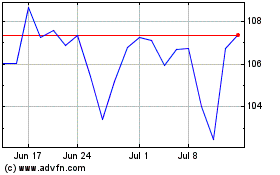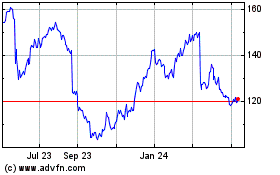Dollar-Store Chains Offer Glum Outlook -- WSJ
August 26 2016 - 3:03AM
Dow Jones News
By Sarah Nassauer
The nation's two biggest dollar-store chains gave a downbeat
assessment of the health of the nation's poorest shoppers, who are
being squeezed by rising rents and health-care bills.
"I know that when we look at globally the overall U.S.
population, it seems like things are getting better," Dollar
General Chief Executive Todd Vasos said on a conference call. But
for the chain's core shopper, "things have not gotten any better
for her. And arguably they are worse."
Dollar General Corp. said sales growth in existing stores slowed
to 0.7% in the second quarter from 2.2% in the preceding quarter.
Mr. Vasos said changes to food-stamp programs in around 20 states
this April that cut off benefits for hundred of thousands of people
hurt sales, as did falling food prices and the need to compete with
rivals on pricing.
At Dollar Tree Inc., same-store sales increased 1.2%, slower
than the prior quarter and below analysts' forecasts. Dollar Tree
CEO Bob Sasser said the consumer is facing rising costs such as
rent and food. "We see them as still being under pressure," Mr.
Sasser said. "I think that's the No. 1 issue that we see out
there."
The rare disappointment in the two chains' financial results
took a toll on their stocks. Shares of Dollar General fell 16% to
$77.40, while Dollar Tree shares declined 9.4% to $86.
Dollar stores have been a relative bright spot in a troubled
retail sector as recession-weary shoppers flocked to their low
prices and convenient locations near residential areas. The two
chains have been growing rapidly as others retrench. Dollar Tree
acquired rival Family Dollar last year for about $9 billion. Dollar
General is adding thousands of stores, aiming to have 20,000 shops
by 2020, up from 13,000.
But improving operations at Wal-Mart Stores Inc. are likely
putting pressure on the retailers. Last week Wal-Mart reported its
eighth straight quarter of sales growth in existing stores, with a
1.6% gain. Executives have said the world's largest retailer by
revenue is beginning to invest billions to lower prices on some
products, forcing smaller players to do the same.
"I believe everyone knows some of the retailers that are working
price right now," Dollar General's Mr. Vasos said without naming
Wal-Mart. To fight back, the dollar chain has lowered prices by an
average of 10% on hundreds of best-selling products in 2,200 of its
stores. "For our core consumer, price is everything."
Both chains have been seeking ways to drive traffic and fend off
competition from online retailers or massive Wal-Mart stores often
on the outskirts of town. Dollar General has said it would add more
fresh foods and health and beauty products to its aisles. Dollar
Tree has highlighted more seasonal items like decorations and
gifts. Both are rapidly expanding.
But declining food prices hit Dollar General. The retailer said
prices for everything from milk and eggs to sugar and coffee hit
its sales growth, a trend executives forecast will continue through
the end of the year. "As we all know, the consumers don't consume
that much more just because the price is a little less expensive,"
said Mr. Vasos.
In all, Dollar General reported a profit increase of 8.5% to
$306.5 million, while revenue rose 5.8% to $5.39 billion.
Meanwhile, Dollar Tree reported a profit of $170.2 million,
compared with a year-earlier loss of $98 million, helped by the
Family Dollar acquisition. Revenue increased to $5 billion from
$3.01 billion.
--Joshua Jamerson and Lisa Beilfuss contributed to this
article.
Write to Sarah Nassauer at sarah.nassauer@wsj.com
(END) Dow Jones Newswires
August 26, 2016 02:48 ET (06:48 GMT)
Copyright (c) 2016 Dow Jones & Company, Inc.
Dollar Tree (NASDAQ:DLTR)
Historical Stock Chart
From Mar 2024 to Apr 2024

Dollar Tree (NASDAQ:DLTR)
Historical Stock Chart
From Apr 2023 to Apr 2024
